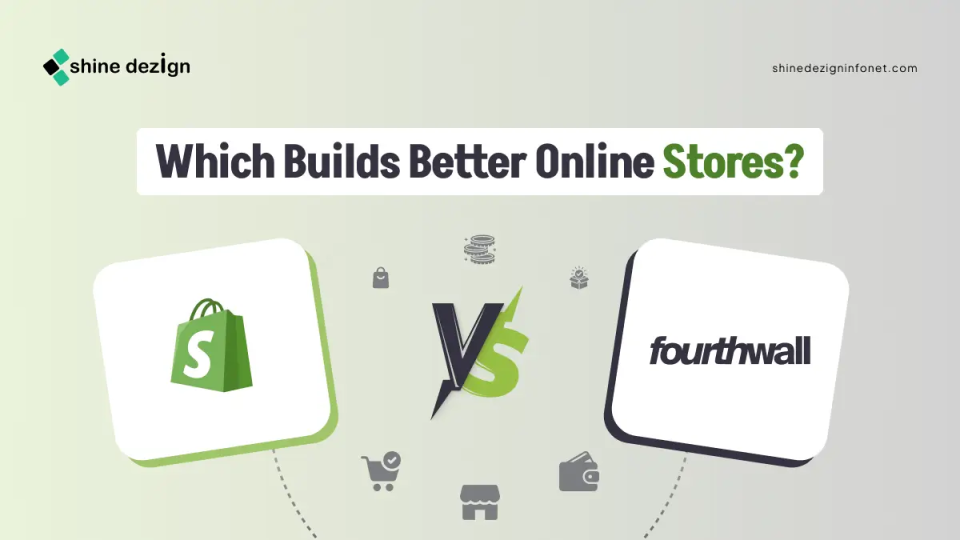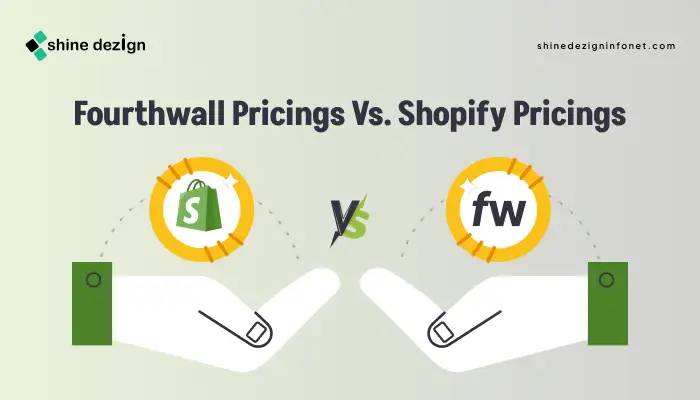Table of Contents
Merch stores help YouTubers, streamers, artists, and small businesses turn fans into revenue. With Fourthwall and Shopify as top options, deciding between them can be tricky. Fourthwall offers simple print-on-demand (POD) merch for creators, while Shopify delivers broad e-commerce tools for various sales.
This comparison of Fourthwall vs Shopify reviews their merch strengths, including Fourthwall fees and pricing, pros, cons, and features. Whether you are a beginner or expanding, we will guide you thoroughly on how to builds a better store for smooth, profitable operations.
About: Fourthwall Vs. Shopify
Fourthwall
Fourthwall is an e-commerce solution tailored specifically for creators. It enables them to design and launch personalized online stores without the complexities of inventory management, manufacturing, or logistics. Users can offer a wide array of merchandise, from apparel and accessories to custom novelty items, while integrating seamlessly with major social media platforms.
Additionally, features like membership programs allow for recurring income through exclusive fan perks. With no substantial upfront fees, Fourthwall lowers the entry barrier, making it an attractive option for those building their entrepreneurial ventures.
Shopify
Shopify provides a complete set of tools to build customizable online stores, manage inventory, process payments, and handle orders, without needing advanced coding knowledge. Whether selling physical products, digital downloads, services, or using dropshipping, users can personalize their store easily. Popular options include themes like Yuva and Fame, and apps such as Perksy Memberships or Advanced PreOrder, which add extra flexibility. With features like abandoned cart recovery, SEO optimization, and multi-channel selling (e.g., via social media or marketplaces), Shopify also supports global operations.
Fourthwall Pros Vs. Shopify Pros
Pros of Fourthwall
Fourthwall excels in simplifying the path from creative idea to customer delivery, positioning itself as a creator-centric ecosystem.
-
- User-Friendly Setup and Customization: The platform’s no-code interface empowers users to build professional-grade online shops with minimal technical expertise. Creators retain full control over pricing strategies, ensuring they capture the majority of profits after straightforward flat fees. This accessibility is particularly beneficial for emerging talents who may lack dedicated design or development resources.
-
- Streamlined Fulfillment and Support: By partnering with established global manufacturers, Fourthwall manages production, shipping, and customer service for standard catalog items. This hands-off approach allows creators to prioritize content production and audience engagement. Worldwide fulfilment networks ensure efficient delivery, often within 5-8 business days, enhancing customer satisfaction and brand loyalty.
-
- Scalability and Integration Capabilities: With robust integrations across platforms like YouTube, Instagram, and Twitch, sales can occur directly within familiar social environments. The absence of minimum order quantities for most products supports experimentation and growth, while membership tools foster long-term community building. This versatility makes it ideal for creators aiming to expand from one-off sales to diversified income models.
- Quality Assurance: Emphasis on premium materials, such as heavyweight fabrics and eco-friendly options, upholds product standards that align with modern consumer expectations. This reliability contributes to positive word-of-mouth and repeat business, crucial for fan-driven economies.
Pros of Shopify
Shopify’s versatility and reliability have made it a go-to choice for over a million merchants, emphasizing ease of use alongside powerful growth tools.
-
- Extensive Customization and Design Flexibility: With a vast library of professional themes (many free or low-cost) and an intuitive drag-and-drop editor, users can craft visually appealing, mobile-responsive stores without deep technical skills. Advanced customization via Liquid code or third-party apps allows for unique branding, catering to diverse industries from fashion to tech.
-
- Seamless Operations and Scalability: Built-in tools for inventory management, order fulfilment, and shipping integrations (e.g., with USPS, UPS, or dropshipping services like Oberlo) streamline day-to-day workflows. The platform scales effortlessly from startups to enterprises, handling high traffic volumes and international sales with multi-currency support and localized checkout experiences.
-
- Robust Ecosystem and Integrations: Access to the Shopify App Store, boasting over 8,000 apps, enables enhancements for marketing (e.g., email automation via Klaviyo), analytics (Google Analytics integration), and payments (Shopify Payments for low fees). Point-of-sale (POS) systems extend functionality to in-person sales, while social commerce ties into platforms like Instagram and Facebook for broader reach.
- Security and Reliability: As a PCI-compliant platform, Shopify prioritizes data protection with features like fraud analysis and secure hosting. Its 99.98% uptime ensures consistent performance, fostering customer trust and supporting long-term business stability.
Cons: Fourthwall Vs. Shopify
Cons of Fourthwall
While Fourthwall streamlines many aspects of e-commerce, it is not without challenges that may impact certain users.
1) Potential Cost Accumulations: Although base fees remain transparent and competitive, additional charges or a 5% cut on digital products and memberships can erode margins, especially for high-volume operations. Niche or highly customized items may also introduce minimum order thresholds, potentially delaying launches or increasing expenses.
2) Constraints on Autonomy: As the designated merchant of record, Fourthwall oversees taxes, disputes, and support for catalog products, which can limit direct control. Creators handling self-shipped or bespoke items must manage these elements independently, adding administrative burdens. Shipping costs, passed directly to customers, may vary significantly by region, influencing purchase decisions.
3) Adaptation Challenges: For those already embedded in alternative ecosystems like Shopify or Patreon, the transition could involve a learning curve. The platform’s focus on digital creators means it may not suit traditional retail businesses lacking a robust online following, where more generalized e-commerce tools might provide better flexibility.
4) Feature Limitations: While functional, the analytics and marketing tools are relatively basic, lacking the depth of specialized software. Creators pursuing advanced data-driven strategies or intricate promotional campaigns may need to supplement with third-party solutions.
Cons of Shopify
Despite its strengths, Shopify’s comprehensive nature can introduce complexities and costs that may challenge certain users.
1) Subscription and Transaction Fees: If not using Shopify Payments, third-party gateways incur extra transaction fees (up to 2%), potentially reducing margins. Add-on apps often come with their own subscriptions, leading to cumulative expenses.
2) Learning Curve for Advanced Features: While beginner-friendly for basics, achieving sophisticated customizations or optimizing apps requires time and possibly developer help. Non-technical users might find the sheer volume of options overwhelming, delaying store launches or necessitating external support.
3) Limited Built-In Tools for Niche Needs: Core features excel in general e-commerce but may fall short for specialized requirements, such as advanced B2B functionality or ultra-complex inventory systems, without premium apps. International sellers could face hurdles with varying tax compliance or language support outside major markets.
4) Dependency on the Ecosystem: Heavy reliance on apps for expansions means potential compatibility issues or performance slowdowns if not managed well. Customer support, while available 24/7, is often community-driven for lower-tier plans, which may not suffice for urgent enterprise-level queries.
Fourthwall Pricings Vs. Shopify Pricings
Fourthwall Pricings
| Plans | Pricings |
|---|---|
| Free | $ 0/Month |
| Pro | $ 19/Month |
Shopify Pricings
| Plans | Pricing |
|---|---|
| Basic | $ 29/Month |
| Grow | $ 79/Month |
| Advanced | $ 299/Month |
| Plus | $ 2300/Month |
Features: Fourthwall Vs. Shopify
| Feature | Shopify | Fourthwall |
|---|---|---|
| Target Audience | General businesses, entrepreneurs, and enterprises across industries (e.g., retail, services, B2B). | Digital creators (e.g., YouTubers, streamers, artists) with fan communities focused on merch and memberships. |
| Setup and Ease of Use | Intuitive drag-and-drop builder with 100+ themes. No-code for basics, but advanced customization requires Liquid coding or apps. Steeper learning curve for complex setups. | No-code shop builder tailored for creators; quick launch in minutes. Highly intuitive for non-tech users, with pre-built templates focused on merch and fan pages. |
| Product Catalog | Unlimited products; supports physical, digital, services, and POD via apps (e.g., Printful integration). Full inventory tracking and variants. | Focus on POD merch (apparel, accessories, custom items like mugs/hot sauce); 100+ catalog items with no inventory needed. Limited to creator-style products; digital downloads and memberships supported. |
| Fulfilment & Shipping | Integrates with third-party services (e.g., ShipStation, dropshipping apps). Handles orders but requires setup for automation. Global shipping options; multi-currency/tax compliance built-in. | Fully managed POD fulfilment: production, printing, and shipping (5-8 days avg.) via global partners. Handles taxes and duties as merchant of record; no minimum orders for most items. |
| Integrations | Vast ecosystem: 8,000+ apps for marketing (e.g., Klaviyo), analytics (Google), POS, social (Instagram/Facebook Shops), and marketplaces (Amazon, Etsy). Extensive API for custom builds. | Native integrations with creator platforms (YouTube, Twitch, Instagram, TikTok). Limited app ecosystem; focuses on social selling and memberships. No broad marketplace ties. |
| Customization Options | High flexibility: Custom themes, domains, checkout, and apps for unique branding. Supports headless commerce for advanced users. | Moderate: Creator-focused themes and design tools (e.g., mockup generators). Less flexible for non-merch elements; tied to their POD ecosystem. |
| Marketing & Analytics | Advanced built-in tools: SEO, email marketing, abandoned cart recovery, and Google Analytics integration. Detailed reports on sales, traffic, and customer behaviour; app expansions for deeper insights. | Basic analytics for sales and fan engagement. Membership tools for exclusive content; social integrations drive traffic, but lacks advanced SEO or email automation without external tools. |
| Customer Support | 24/7 chat/email/phone; community forums. Priority support on higher plans; extensive help docs and Shopify Academy. | Handles support for catalog items (under 12 hours response). Creator self-service for custom items; email/ticket system with dedicated creator resources. No 24/7 chat. |
| Scalability | Excellent for growth: Handles high-volume traffic, international expansion, and enterprise features (e.g., wholesale channels). Ideal for multi-store or omnichannel setups. | Strong for creator growth: Scales with audience size via memberships and social ties. Less suited for non-creator or high-complexity ops; caps at POD/merch focus. |
| Security & Compliance | PCI DSS compliant; fraud detection, secure hosting (99.98% uptime). GDPR-ready with data export tools. | PCI compliant; secure payments and data handling. As merchant of record, manages sales tax/VAT compliance for POD items. |
| Unique Selling Points | All-in-one e-commerce suite with POS for in-person sales; robust for B2B/international. | Creator-specific perks like fan memberships, no-inventory POD, and 100% profit retention after fees. Emphasizes community over traditional retail. |
| Potential Drawbacks | Higher ongoing costs; app dependencies can fragment experience; more setup required for POD. | Limited to the creator niche; less control over fulfilment disputes; basic tools may require supplements for advanced marketing. |
What to Choose and Why: Fourthwall Vs. Shopify?
Choose Fourthwall If You Want:
- Its creator-first design makes setup intuitive and tailored to fan engagement.
- Seamless social integrations (e.g., direct selling on Instagram or Twitch) drive quick launches.
- Zero monthly fees (beyond Fourthwall fees per sale) keep costs low for experimentation.
- Builds a merch store that feels like an extension of your content, with memberships for recurring revenue.
- Ideal for low-overhead, fan-focused sales in the creator economy.
Choose Shopify If You Want:
- Its robust ecosystem excels in customization and growth tools for established brands.
- Integrate POD apps like Printful for merch while handling unlimited products and variants.
- Offers full control over branding, analytics, and multi-channel selling (e.g., POS for in-person or marketplaces like Amazon).
- Scales effortlessly for high-volume traffic and global operations, despite subscription costs.
- Better for complex setups, though it requires more initial configuration for pure merch.
Conclusion
Fourthwall vs. Shopify comes down to what fits your merch goals; there’s no perfect winner for everyone. Fourthwall shines for creators with its simple, fan-friendly setup and low fees, making it easy to sell merch without hassle. Shopify offers more power and flexibility, ideal for growing businesses that want advanced tools and scalability.
Ready to Start? Use Fourthwall for straightforward creator tools or hire a Shopify Expert to enjoy full e-commerce features and build your own store.



















One reply on “Fourthwall vs Shopify: Which Builds Better Online Stores?”
Great comparison! I’ve used Shopify before, and this article really cleared up some doubts I had about Fourthwall. Looking forward to trying it out.